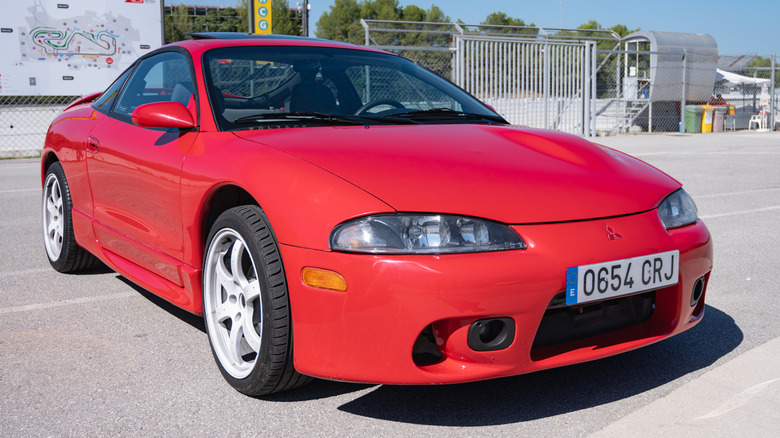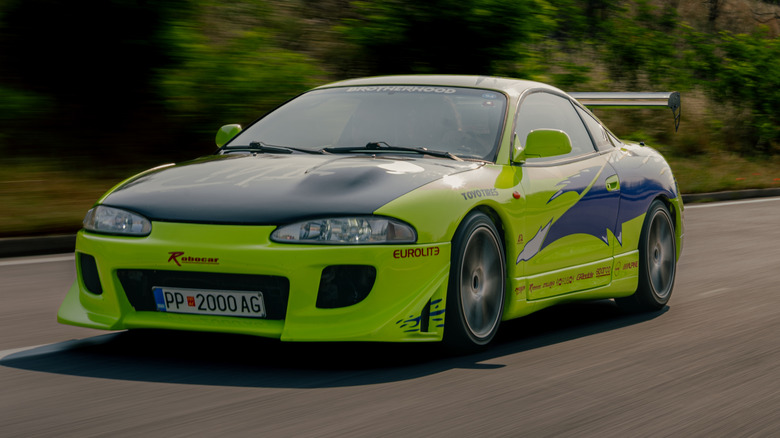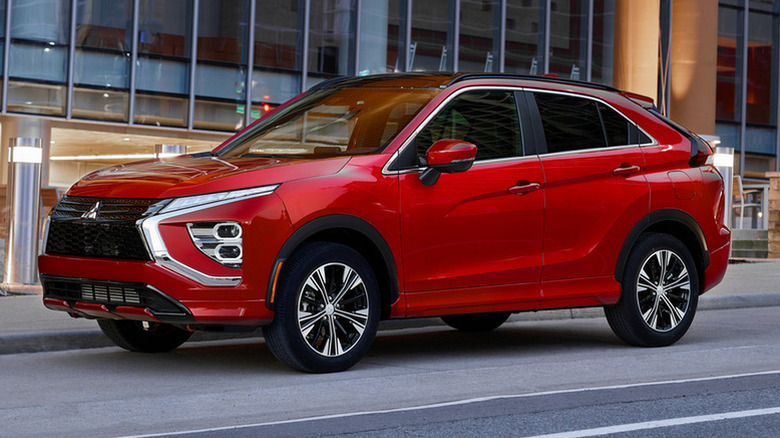Why Did The Mitsubishi Eclipse Have A Bump On The Hood?
Although the name is now associated with an affordable crossover SUV, the original Mitsubishi Eclipse was a fun-to-drive sports coupe with truly unique styling. The Mitsubishi Eclipse was originally designed for the U.S. market by Mitsubishi Motors North America Design Studio and built at the Mitsubishi plant in Normal, Illinois. Mitsubishi named the sports coupe after an 18th-century English racehorse, which never lost a race in its career.
In its first generation, the Mitsubishi Eclipse featured a noticeable bump on its hood right in front of where the driver sat. What seemed like an odd design choice actually had a legitimate application. The engine that Mitsubishi used in the Eclipse, dubbed the 4G63, featured a turbocharged 2.0-liter unit that was capable of producing up to 195 horsepower. The timing pulleys that were used in the 4G63 rose just above the rest of the components in the engine bay and had a large plastic covering. The noticeable bump in the hood of the Eclipse indicated where the plastic cover was.
Unfortunately, Mitsubishi discontinued the Eclipse line of sports coupes in 2012 after producing the 2012 Mitsubishi Eclipse Special Edition. That model offered drivers two engine options: either a 2.4-liter four-cylinder with 162 horsepower or a 3.8-liter V6 with 265 horsepower.
Generations of the Mitsubishi Eclipse
Mitsubishi produced five different generations of the Eclipse between 1989 and 2012. The first generation of the Mitsubishi Eclipse was available from 1989 to 1994 and shared the same platform as the Plymouth Laser and Eagle Talon. Mitsubishi had a partnership with Chrysler to jointly develop and build the vehicle. Eclipse models with the previously mentioned 4G63 engine were also available with all-wheel drive.
The second generation of the Eclipse — which was available from 1995 to 1999 — was also built in a partnership with Chrysler. This model rose to fame when Paul Walker's character Brian drove it in "The Fast and the Furious". You may remember it with green and blue livery, last seen getting shot at and exploding.
The third generation of the Eclipse was also the last year Mitsubishi partnered with Chrysler. Built from 2000 to 2005, this version of the Eclipse was not nearly as well-received as the previous two generations, due to increased prices and less-aggressive looks. The third-gen Eclipse was built alongside the Chrysler Sebring Coupe. Entering its fourth generation in 2005, the new Eclipse featured a sportier design and more powerful engines. The 3.8-liter V6 that Mitsubishi included in some trims was capable of producing 260 horsepower.
The final Eclipse generation — which ran from 2009 to 2012 — featured more aggressive design choices and evoked the sense of a sports car more than it had in the past. Unfortunately, with a power increase of just 5 horsepower over the fourth-generation Eclipse, the final run of Mitsubishi's sports coupe left a lot to be desired.
The Mitsubishi Eclipse's successor
There has been a trend among automakers where the names of cars or sports cars are added to SUVs to make them feel sportier. Some prime examples are the Ford Mustang Mach-E electric SUV, the Toyota Corolla Cross SUV, and the Mitsubishi Eclipse Cross SUV. The last of these vehicles, the Eclipse Cross, bears little resemblance to the vehicle it was based on.
Introduced in 2017 as a 2018 model, the Mitsubishi Eclipse Cross is an affordable compact SUV. Mitsubishi claimed it "brings advanced technology to a whole new class of consumers." While Mitsubishi may have hit that mark, it swung and missed when it came to evoking the feel of the original Eclipse. Outside of a front grille featuring the Mitsubishi logo, there's little that the iconic sports coupe and affordable SUV have in common. Where the final generation of the Eclipse featured a powerful 265-horsepower engine, the Eclipse Cross originally offered a passive 152-horsepower turbocharged four-cylinder. As of 2025, Mitsubishi does not offer an exciting performance-oriented variant of the Eclipse Cross. The 2025 model features the same 152-horsepower turbo-four that was available in 2017.


